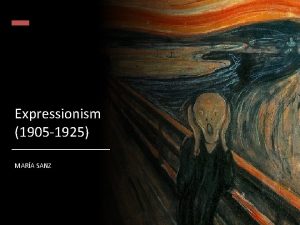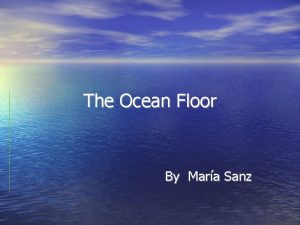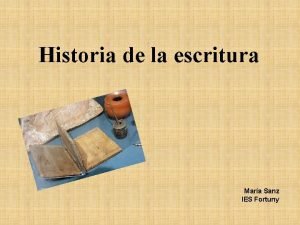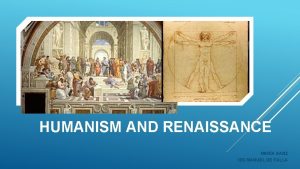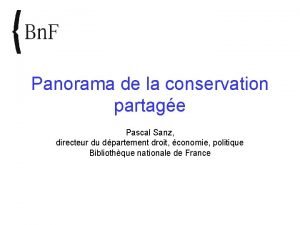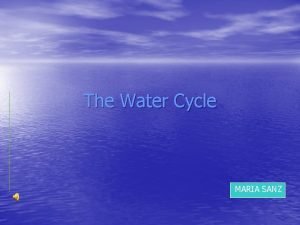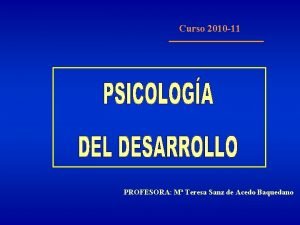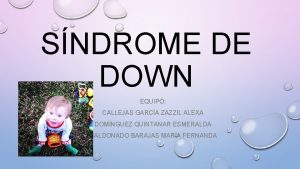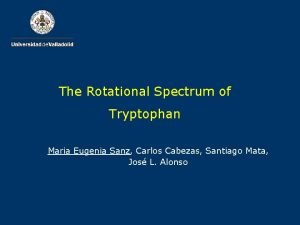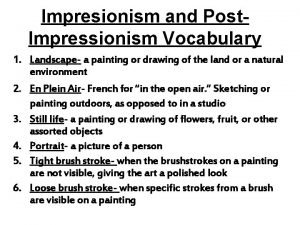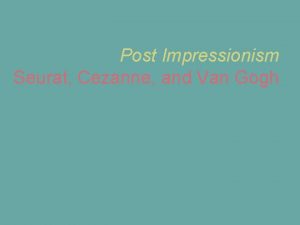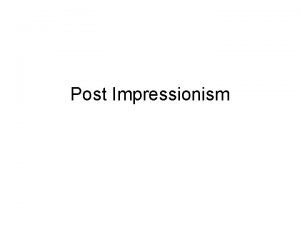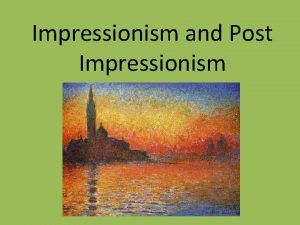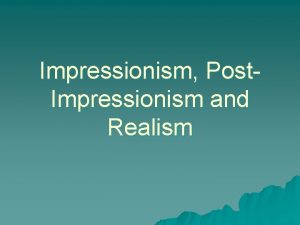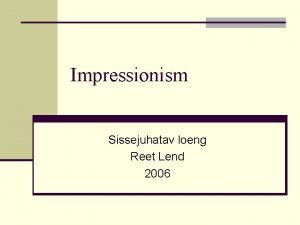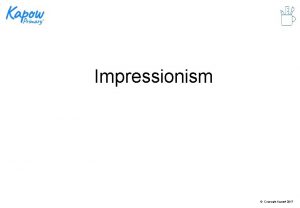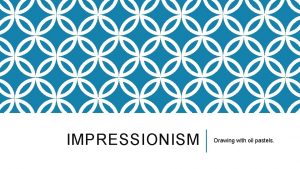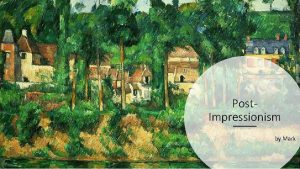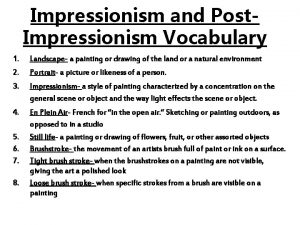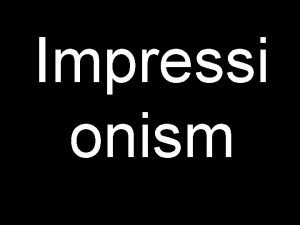POST IMPRESSIONISM MARA SANZ Post Impressionism At the


















- Slides: 18

POST - IMPRESSIONISM MARÍA SANZ

Post Impressionism At the end of the 19 th century / beginning of the 20 th century, artists began to develop more personal styles The main Post Impressionist artists were Paul Cezanne, Vincent Van Gogh and Paul Gauguin These artists would be highly influential to the Cubist, Expressionist and Fauve movements of the 20 th century

Post Impressionism Characteristics of the Post Impressionist Style: Painting Compositions describing form in terms of its underlying geometric structure - eg sphere, cone, cube, cylinder etc (Cezanne) Use of colour contrasts for defining surfaces and forms (Cezanne/ Van Gogh/ Gauguin) Use of Advancing and Receding colours to create depth in painting (Cezanne/ Van Gogh) Less emphasis on accuracy in drawing (Van Gogh) Use of parallel and Expressive brushstrokes (Cezanne/ Van Gogh)

Post Impressionism Characteristics of the Post Impressionist Style: Use of pure colour with a great emotive charge (Van Gogh) Paintings with extreme diagonals and curved brushstrokes that tend to express anguish and depression (Van Gogh) Creation of simplified, flat painting compositions based on shapes (Gauguin) Harmonious and bright colour use (Van Gogh/ Gauguin)

Paul Cezanne • His paintings covered the use of structure and volume through the use of geometric shape, and definition of the forms through painted parallel brushstrokes • He tended to use primary and secondary and tertiary colours • He used contrasts and tones to build 3 D form • He used advancing and receding colour to create depth, and he sometimes used multiple viewpoints • His belief that “Everything in Nature adheres to the sphere, cylinder, cone and cube” was a main basis for his paintings of all subject matter • He influenced the 20 th century Cubist movement

Paul Cezanne best known for his : Still Life Portraits Landscapes

Vincent Van Gogh • He painted curved, wavy brush marks in his landscapes • His brushstroke is very characteristic -wavy, sinuous, or diagonal and thick • Colours used are often aggressive with use of opposite colours and contrasts (blue next to orange) • His use of colour is highly emotive and expressive • He was to influence the movement Expressionism in the 20 th century

Vincent Van Gogh Van - Gogh best known for his Still Life Portraits Landscapes

Paul Gauguin • His work has elements of symbolism in it • Flat shapes and bold colours are used • Little or no use of perspective • Colours used are often vivid with use of opposite colours and contrasts • His use of colour is highly expressive • He lived in Tahiti for most of his later life • He was to influence the movement Fauvism in the 20 th century

Paul Gauguin - best known for his Portraits Landscapes with figure Tahitian women/nudes

HENRY ROUSSEAU He is well-known for his colorful jungle scenes and meticulous brush strokes. His style is known as primitivism. He painted some portraits but most of his works come from his imagination and are like dreams. He was a self-taught painter, so his paintings look like child -like and the artists that use this style are called naïve.

HENRY ROUSSEA U Famous for: 1. Portraits 2. Jungle scenes 3. Imaginative landscapes.

HENRY TOULOUSELAUTREC Henri Toulouse-Lautrec was rich but disabled. He lived in Paris and portrayed the nightlife of Paris, especially the Moulin Rouge, a popular cabaret at the time. He was good at drawings in paint and sometimes he used pastel colors for his drawings. Toulouse-Lautrec also designed posters to advertise entertainments and theatres.

HENRY TOULOUSELAUTREC Famous for: 1. Portraits 2. Popular threatre and cabaret scenes 3. Posters advertising enterteiments 4. Pastel drawings

HENRY TOULOUSE LAUTREC

GEORGES SEURAT Georges Seurat collaborated with the Impressionists. He was interested in the effects of light on color. Seurat studied the light and realized it was divided in multiple particles He painted in hundreds of tiny dots of bright color. This style is known as pointillism.

GEORGE SEURAT Seurat is famous for: 1. Landscapes 2. Portraits 3. Pointillism 4. Use of bright colors 5. Plain surfaces

GEORGE SEURAT
 Mesaj expresionist apelativ
Mesaj expresionist apelativ Mara sanz
Mara sanz Ies fortuny
Ies fortuny Mara sanz
Mara sanz Impressionism vs post impressionism
Impressionism vs post impressionism Hidrogeologia
Hidrogeologia Pascal sanz
Pascal sanz Sanz water
Sanz water Nuria sanz unesco
Nuria sanz unesco Teresa sanz cotilleo
Teresa sanz cotilleo Alexa callejas fotos
Alexa callejas fotos Eugenia sanz
Eugenia sanz A sanz
A sanz Grib hib
Grib hib Gaspar sanz
Gaspar sanz Impresionism painting
Impresionism painting Cezanne pointillism
Cezanne pointillism Characteristics of post-impressionism
Characteristics of post-impressionism Post-impressionism characteristics
Post-impressionism characteristics
